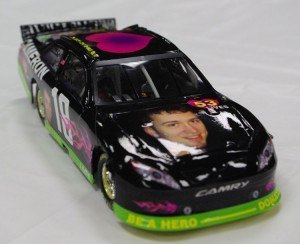A Hero's Message on a Racetrack
Cameron Greenwood is a hero to his family. They wanted to share that message with the world.
Less than six months after Cameron passed away from struggles with diabetes and saved or enhanced the lives of 53 individuals through organ and tissue donation, his family submitted a NASCAR racecar design to a national contest. The car featured Cameron’s picture and the message of organ and tissue donation.
“Our society sees everyday heroes as police officers, firefighters, teachers and things like that,” said Stacey Smith, Cameron’s mother. “But we tend to forget that organ and tissue donors are saving lives every day by countless numbers. We wanted to bring that to the forefront, that these people are unnamed heroes. It’s incredible how many lives are being saved.”
Cameron’s Battle with Diabetes
Cameron learned he had type 1 diabetes at 16 years old. Thinking he had the flu, he waited to go to the doctor. The delay nearly cost him his life then. Doctors diagnosed him with diabetic ketoacidosis, a condition that occurs when the body can’t use sugar as a fuel source because there is no insulin or not enough insulin. As a result, fat is used for fuel, and the byproduct builds up in the body.
Five years after the initial diagnosis, Cameron had another ketoacidosis flare up in December of 2010. He went into cardiac arrest and was rushed to the hospital.
“He had a check up about two weeks before everything happened,” Stacey said. “His blood sugar was fine. That weekend he thought he had the flu, but it was ketoacidosis again.”
He spent one day in a coma. Eight months earlier, Cameron talked to his wife, Tawny, about organ and tissue donation. He joined the organ and tissue donor registry at his local license office.
“We prayed over his organs and for healing all day,” Stacey said. “That night he stabilized and they thought he was going to pull through so they sent everyone home. I stayed and at 11 o’clock that night I went in to tell him good night.”
As Stacey ran her fingers through Cameron’s hair and sang a lullaby she sang to him as a child, he had tears running from his eyes. It was the only response he had given all day to numerous requests from his family. Stacey left the room to get a friend.
“He passed away as soon as I left the room,” she said.
The No. 18 car for 53 lives saved
Stacey’s boyfriend, Joe, designed the NASCAR through a contest by Toyota Sponsafier. More than 50,000 entries were received.
Through a national vote, Cameron’s car was in the top 10 going into the last few weeks.
The black car with hot pink flames down the side (Cameron’s favorite colors) has his picture on the hood. His children, four-year-old Elijah and one-year-old Faith, are under the back window. The heart on the roof represents Cameron’s heart, which was donated with his two kidneys. The number 53 represents the number of lives Cameron saved or enhanced. The green bar at the bottom of the car is the same green used by Donate Life.
Shortly before the contest was to end, Cameron’s car was pushed back to 14th.
“We thought at that point, ‘There’s nothing we can do, it’s over,’” Stacey said. “But the judges put the car into the top 10. A lot of it had to do with the design, the reason behind the car and what we were representing. They thought it was an important issue.”
Donors are Heroes
Cameron’s family encouraged the communities near Branson to vote for the car. As a result, many people joined the registry. “What surprised us the most was the number of people in the local area that were supporting him,” Stacey said. “We were finding out there were so many people Cameron had done things for that we didn’t even know about. All of these people started coming from nowhere telling their story with Cameron. It was amazing to see the response from the people he had done things for.”
The car became part of grieving for Cameron’s family. They used his car to tell of their hero.
“It was part of the grieving process for us because before Cameron died, we had always thought of organ donation as being so clinical and a medical thing,” Stacey said. “When you think about organ donation, you often think about the recipient and not the life that the organ came from. We really wanted to bring light to the idea that donors are heroes.”

